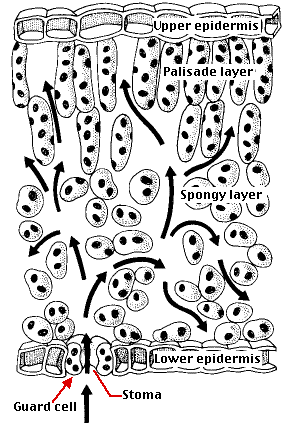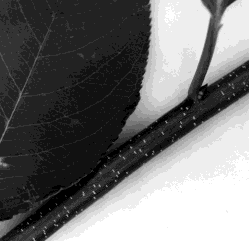Plants Take in What and Release Oxygen Gas
16.2D: Gas Exchange in Plants
-
- Last updated
- Save as PDF
- Page ID
- 5785
In order to carry on photosynthesis, green plants need a supply of carbon dioxide and a means of disposing of oxygen. In order to carry on cellular respiration, plant cells need oxygen and a means of disposing of carbon dioxide (just as animal cells do). Unlike animals, plants have no specialized organs for gas exchange (with the few inevitable exceptions!). The are several reasons they can get along without them:
- Each part of the plant takes care of its own gas exchange needs. Although plants have an elaborate liquid transport system, it does not participate in gas transport.
- Roots, stems, and leaves respire at rates much lower than are characteristic of animals. Only during photosynthesis are large volumes of gases exchanged, and each leaf is well adapted to take care of its own needs.
- The distance that gases must diffuse in even a large plant is not great. Each living cell in the plant is located close to the surface. While obvious for leaves, it is also true for stems. The only living cells in the stem are organized in thin layers just beneath the bark. The cells in the interior are dead and serve only to provide mechanical support.
- Most of the living cells in a plant have at least part of their surface exposed to air. The loose packing of parenchyma cells in leaves, stems, and roots provides an interconnecting system of air spaces. Gases diffuse through air several thousand times faster than through water. Once oxygen and carbon dioxide reach the network of intercellular air spaces (arrows), they diffuse rapidly through them.
- Oxygen and carbon dioxide also pass through the cell wall and plasma membrane of the cell by diffusion. The diffusion of carbon dioxide may be aided by aquaporin channels inserted in the plasma membrane.
Leaves
The exchange of oxygen and carbon dioxide in the leaf (as well as the loss of water vapor in transpiration) occurs through pores called stomata (singular = stoma).

Normally stomata open when the light strikes the leaf in the morning and close during the night. The immediate cause is a change in the turgor of the guard cells. The inner wall of each guard cell is thick and elastic. When turgor develops within the two guard cells flanking each stoma, the thin outer walls bulge out and force the inner walls into a crescent shape. This opens the stoma. When the guard cells lose turgor, the elastic inner walls regain their original shape and the stoma closes.
| Time | Osmotic Pressure lb/in2 |
|---|---|
| 7 A.M. | 212 |
| 11A.M. | 456 |
| 5 P.M. | 272 |
| 12 Midnight | 191 |
The table shows the osmotic pressure measured at different times of day in typical guard cells. The osmotic pressure within the other cells of the lower epidermis remained constant at 150 lb/in 2 (~1000 kilopascal, kPa). When the osmotic pressure of the guard cells became greater than that of the surrounding cells, the stomata opened. In the evening, when the osmotic pressure of the guard cells dropped to nearly that of the surrounding cells, the stomata closed.
Opening stomata
The increase in osmotic pressure in the guard cells is caused by an uptake of potassium ions (K + ). The concentration of K + in open guard cells far exceeds that in the surrounding cells. This is how it accumulates:
- Blue light is absorbed by phototropin which activates a proton pump (an H + -ATPase) in the plasma membrane of the guard cell.
- ATP, generated by the light reactions of photosynthesis, drives the pump.
- As protons (H + ) are pumped out of the cell, its interior becomes increasingly negative.
- This attracts additional potassium ions into the cell, raising its osmotic pressure.
Closing stomata
Although open stomata are essential for photosynthesis, they also expose the plant to the risk of losing water through transpiration. Some 90% of the water taken up by a plant is lost in transpiration. In angiosperms and gymnosperms (but not in ferns and lycopsids), Abscisic acid (ABA) is the hormone that triggers closing of the stomata when soil water is insufficient to keep up with transpiration (which often occurs around mid-day).
The mechanism:
- ABA binds to receptors at the surface of the plasma membrane of the guard cells.
- The receptors activate several interconnecting pathways which converge to produce
- a rise in pH in the cytosol
- transfer of Ca 2+ from the vacuole to the cytosol
- These changes stimulate the loss of negatively-charged ions (anions), especially NO 3 − and Cl − , from the cell and also the loss of K + from the cell.
- The loss of these solutes in the cytosol reduces the osmotic pressure of the cell and thus turgor.
- The stomata close.
Open stomata also provide an opening through which bacteria can invade the interior of the leaf. However, guard cells have receptors that can detect the presence of molecules associated with bacteria called pathogen-associated molecular patterns (PAMPs). LPS and flagellin are examples. When the guard cells detect these PAMPs, ABA mediates closure of the stoma and thus close the door to bacterial entry.
This system of innate immunity resembles that found in animals.
Density of stomata
The density of stomata produced on growing leaves varies with such factors as the temperature, humidity, and light intensity around the plant. It also depends on the the concentration of carbon dioxide in the air around the leaves. The relationship is inverse; that is, as the concentration of CO 2 goes up, the number of stomata produced goes down, and vice versa. Some evidence:
- Plants grown in an artificial atmosphere with a high level of CO 2 have fewer stomata than normal.
- Herbarium specimens reveal that the number of stomata in a given species has been declining over the last 200 years — the time of the industrial revolution and rising levels of CO 2 in the atmosphere.
These data can be quantified by determining the stomatal index: the ratio of the number of stomata in a given area divided by the total number of stomata and other epidermal cells in that same area.
Q&A
How does the plant determine how many stomata to produce?
It turns out that the mature leaves on the plant detect the conditions around them and send a signal (its nature still unknown - but see below * ) that adjusts the number of stomata that will form on the developing leaves.
Two experiments (reported by Lake et al., in Nature, 411:154, 10 May 2001):
- When the mature leaves of the plant (Arabidopsis) are encased in glass tubes filled with high levels (720 ppm) of CO 2 , the developing leaves have fewer stomata than normal even though they are growing in normal air (360 ppm).
- Conversely, when the mature leaves are given normal air (360 ppm CO 2 ) while the shoot is exposed to high CO 2 (720 ppm), the new leaves develop with the normal stomatal index.
* One signal that increases stomatal density in 2-day-old Arabidopsis seedlings (a different experimental setup than the one above) is a 45-amino acid peptide called stomagen that is released by mesophyll cells and induces the formation of stomata in the epidermis above.
Stomata reveal past carbon dioxide levels
Because CO 2 levels and stomatal index are inversely related, could fossil leaves tell us about past levels of CO 2 in the atmosphere? Yes. As reported by Gregory Retallack (in Nature, 411:287, 17 May 2001), his study of the fossil leaves of the ginkgo and its relatives shows:
- their stomatal indices were high late in the Permian period (275–290 million years ago) and again in the Pleistocene epoch (1–8 million years ago). Both these periods are known from geological evidence to have been times of low levels of atmospheric carbon dioxide and ice ages (with glaciers).
- Conversely, stomatal indices were low during the Cretaceous period, a time of high CO 2 levels and warm climate.
These studies also lend support to the importance of carbon dioxide as a greenhouse gas playing an important role in global warming.
Roots and Stems
Woody stems and mature roots are sheathed in layers of dead cork cells impregnated with suberin — a waxy, waterproof (and airproof) substance. So cork is as impervious to oxygen and carbon dioxide as it is to water. However, the cork of both mature roots and woody stems is perforated by nonsuberized pores called lenticels. These enable oxygen to reach the intercellular spaces of the interior tissues and carbon dioxide to be released to the atmosphere.

In many annual plants, the stems are green and almost as important for photosynthesis as the leaves. These stems use stomata rather than lenticels for gas exchange.
Contributors and Attributions
-
John W. Kimball. This content is distributed under a Creative Commons Attribution 3.0 Unported (CC BY 3.0) license and made possible by funding from The Saylor Foundation.
Plants Take in What and Release Oxygen Gas
Source: https://bio.libretexts.org/Bookshelves/Introductory_and_General_Biology/Book%3A_Biology_(Kimball)/16%3A_The_Anatomy_and_Physiology_of_Plants/16.02%3A_Plant_Physiology/16.2D%3A_Gas_Exchange_in_Plants
0 Response to "Plants Take in What and Release Oxygen Gas"
Post a Comment